
During 61 years of reign, Emperor Kangxi not only laid emphasis on politics and military affairs, but also showed interest in antiques, calligraphy and paintings, in particular, porcelain. At the time, the court valued porcelain production, and the artisan-registration system of the Ming Dynasty was abolished, which reduced their burden and restraint and hence accelerated the development of the porcelain industry. As a result, more varieties of porcelain were produced, boasting exquisite craftsmanship. There were both porcelain objects for decoration and viewing, and the utensils for daily use. On the whole, bodies of porcelains made in the early period of Emperor Kangxi’s reign were thick and showed the style of the late Ming Dynasty, but they became thinner in the middle and late period. Thanks to the fine texture of the porcelain body and the superb body-shaping techniques, most of the objects were exquisite. Large ones were made according to standards and seldom deformed. They feature vigorous and upright shapes, and never look dull. Small ones of regular shapes look elegant and ingenious. During this period, porcelain bodies feature a fine, pure and hard texture, commonly known as “glutinous rice juice” and showing the beauty similar to that of jade. During Emperor Kangxi’s reign, numerous kinds of colored glaze were famous, such as Lang-ware red glaze, kidney-bean red glaze, sky-blue glaze, snow-flake blue glaze, etc. However, the blue-and-white glaze remained predominant in porcelain production, and such wares were fired in a large number and popular in a wide scope, embodying the prosperous development of blue-and-white porcelain.
The period of Emperor Kangxi’s reign saw another golden age of blue-and-white porcelain production, following periods of Yongle, Xuande, Chenghua and Jiajing. It occupies a unique position in Chinese history of ceramics, with bright and clear colors, exquisitely painted patterns, simple but diversified shapes. In the transitional period at the turn of the late Ming and early Qing Dynasty, some features of the Ming Dynasty still remained on the blue-and-white porcelains produced in the early days of Kangxi’s reign, for example, being shoddily made with a coarse and thick body in dark or blurred blue color, decorated with simple and slovenly patterns, etc. The unsophisticated painting style was more influenced by the style of the Ming Dynasty.
In the middle of Emperor Kangxi’s reign, blue-and-white porcelain production reached its heyday. At the time, the superior raw material discovered in Zhejiang was used to produce different shades of colors, and even one single stroke may present delicately different shades. Only one kind of blue pigment can be used to depict mountains in the background and rivers in the forefront as well as other objects in different directions in bright colors and with a clear structure, well demonstrating the effect of “blue color represented in five tones”. The whole painting shows the strong three-dimensional effect. The technique of shading is also utilized, making the painting closer to or reach the level required by the expression of traditional Chinese painting and similar to an ink wash painting with high value of appreciation. This is one of the major reasons why blue-and-white porcelains made in Emperor Kangxi’s reign have been highly valued by later generations who have praised them in many ways, for example, “Chinese porcelains rank 1st in the world, and those produced during Kangxi and Yongzheng’s reigns are the best”, “strong colors and blue-and-white porcelain produced during Kangxi’s reign are the best”, etc. However, the renowned blue-and-white porcelain gradually declined in the late period of Kangxi’s reign, and the bright and verdant colors in the middle of his reign became light or dark, sometimes the colors being unstable and blurred. Seen from the bright and clear colors on this pair of plates, they should be ascertained to be made in the middle of Emperor Kangxi’s reign.
Subjects of patterns on blue-and-white porcelains during Emperor Kangxi’s reign boast rich content and wide varieties, covering all aspects of the social life and laying more emphasis on reflecting reality and secular life. They mainly include plants, flowers, insects, fish, grass, landscape, human figures, auspicious patterns and long poems, and some are derived from the woodblock prints in the late Ming and early Qing Dynasty. Patterns of human figures were an important part of motifs on blue-and-white porcelains throughout the whole Qing Dynasty, and accounted for a large proportion. The human figures painted on blue-and-white porcelains of Emperor Kangxi’s reign pursued both formal and spiritual resemblance. According to A Discourse on Porcelain from the Yinliu Studio, “The patterns of human figures during Emperor Kangxi’s reign are all excellent. For example, the Eight Drinking Immortals, 18 Scholars, 18 Arhats and others from various stories are all represented in a vivid manner.” Most subjects of human figure patterns are from historical stories and myths or legends, including the Romance of the Three Kingdoms, The Investiture of the Gods, Romance of the West Chamber, Journey to the West, Heroes in Sui and Tang Dynasties, etc. And some scenes from these famous novels are selected, such as “King Wen of Zhou Visiting the Sage”, “Su Dongpo Visiting the Red Cliff at Night”, “Mulan Joining the Army”, “Seven Sages of the Bamboo Grove”, “Daqiao and Xiaoqiao”, “Getting Promoted”, “Pointing at the Rising Sun”, “Eight Drinking Immortals”, and “Child at Play”. At the time, human figures holding weapons and scenes of wars from operas were also popular and they were depicted in a lively and lifelike manner. The blue-and-white porcelains of the Qing Dynasty were painted with numerous human figures from stories, which undoubtedly was a feature of the times.
Now I will introduce a few blue-and-white porcelain wares painted with human figures made in Emperor Kangxi’s reign so as to further your understanding of such subject.
Blue-and-white Chinese staff-shaped vase painted with Hong Fu Nü's story, produced in Emperor Kangxi's reign in the Qing Dynasty, measures 45.3cm in height, 13.3cm in mouth diameter and 14.7cm in foot diameter, and is now in the collection of the Palace Museum. It features a dish-like mouth, short neck, round shoulder, long and straight belly and ring foot, and is painted with blue patterns on the whole body. The belly is painted with scenes from the legend of Hong Fu Nü. The human figure in the center of the painting is Yang Su, an influential minister under Emperor Yang of the Sui Dynasty. Behind him stand two courtesans, one being Zhang Linghua, or Hong Fu Nü. She fell in love with Li Jing who came to pay homage to Yang Su and eloped with him with the Lingjian (arrow as a token of authority) that she stole. The two got married and Hong Fu Nü helped Li attained great accomplishments. This story was also known as “Discovering the Real Talent with Discerning Eyes.” Such vase was invented during Emperor Kangxi’s reign, and was named after its shape like a staff used for washing clothes in ancient China. The body is hard with fine texture, and the blue color is bright and forms a sharp contrast with the white glaze on the ground, of high artistic value for appreciation.
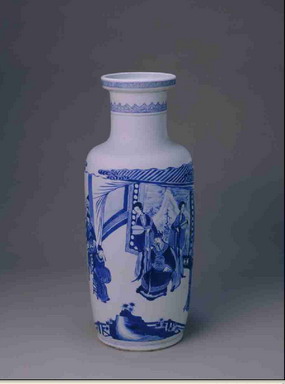
The blue-and-white lidded jar painted with landscape and human figures, made in Emperor Kangxi’s reign in the Qing Dynasty, is now in the collection of the Palace Museum in Beijing. It measures 23.7cm in total height, 23.1cm in mouth diameter, and 14.2cm in foot diameter, and features a straight mouth, short neck and ring foot. The lid of the jar has a flat top, slightly folded rim and ring knob. The body of the jar is decorated with blue patterns of landscape and human figures, which are bright and gorgeous, and show an artistic style of the ink wash painting. The whole painting is clearly structured with the three-dimensional effect. The scholar and the old fisherman are vividly painted. The jar boasts an exquisite and thick body with a fine white texture.
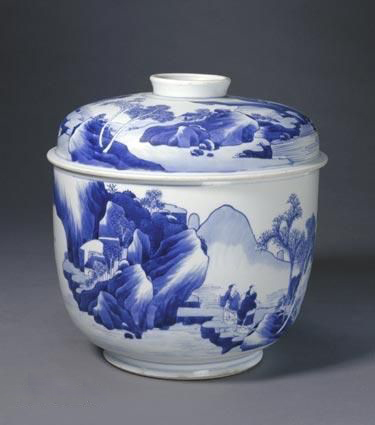
The polychrome vase painted with human figures, made in Emperor Kangxi's reign in the Qing Dynasty, is now in the collection of the Palace Museum in Beijing. It measures 45.1cm in height, 11.9cm in mouth diameter, and 12.8cm in foot diameter, and features a dish-like mouth, upright neck, slanting shoulder, straight belly and ring foot. White glaze is applied both inside and outside, with polychrome patterns on the exterior wall. The mouth rim is decorated with red patterns. The neck is painted with two groups of bamboos, rocks and flowers. The shoulder contains four panels on a rhombic brocade ground, with village and cottage motif in each panel. Patterns on the belly mainly depict a scene of battle from Heroes in Sui and Tang Dynasties: Qin Shubao fights with Yuchi Gong, both on horseback, Li Shimin (the later Emperor Taizong of the Tang Dynasty) and Xu Maogong watch the fight on the city wall. The scene is highlighted by low hills, flowers and trees. Such motif is commonly known as Daomaren in Chinese, literally “people holding a broad knife and riding on a horse.” It was often used to embellish ceramics during Emperor Kangxi’s reign in the Qing Dynasty. The ring foot is applied with white glaze and bears no inscription.
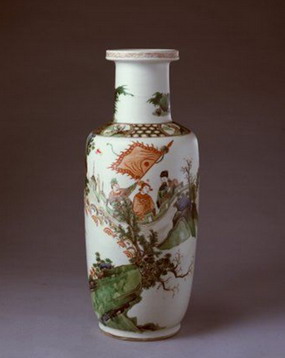
The blue-and-white Meiping vase painted with human figures from the Romance of the West Chamber, created in the Yuan Dynasty, is now in the collection of Victoria and Albert Museum, London, Britain. The patterns represent the scene of interrogating Hongniang: a female holds a cane in her right hand, with her left hand pointing at the other female who covers her face and weeps. (Fig. 1)
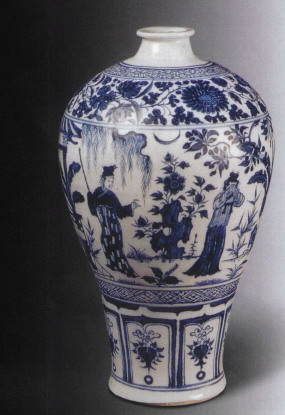
The blue-and-white vase painted with scene of Announcement of Good News from the Romance of the West Chamber, made in the middle of Emperor Kangxi’s reign in the Qing Dynasty, measures 42.9cm in height, 12cm in mouth diameter, and 14cm in foot diameter, and is now in the collection of Shanghai Museum. The blue patterns depict Scene I in Part 5 of the novel: After Zhang Sheng becomes Zhuangyuan, the scholar who came first in the palace examination held in the capital, he sends his boy attendant to tell the good news to Yingying who is reading the notice, full of joy. Hongniang standing beside her also looks happy, and the boy attendant is describing the scene that Zhang Sheng (also known as Zhang Junrui) received people's congratulations in a grand procession.
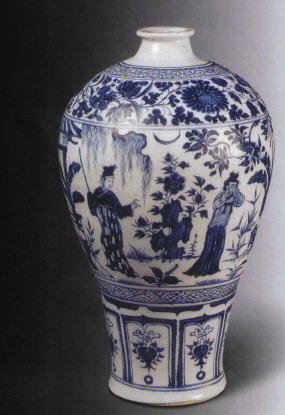
Question 1: Were the plates we talk about here used for decoration or as daily utensils?
Question 2: When did the blue-and-white porcelain first appear, and where was its place of origin?
Your answer please, if you have any questions or answer, please feel free to send us email, we are waiting for your answers and participation, and your comments, answers and suggestions will be highly appreciated. We will select and publicize the most appropriate answers and comments some time in the future.
Weekly Selection Email: meizhouyipin@chnmus.net
The Romance of the West Chamber, a Zaju (literally “variety show”) work written by Wang Shifu, occupies an important position in Chinese history of literature. Since its publication, it has attracted readers of different times with its elegant style and unique theme. It tells a love story between Zhang Junrui, a young scholar, and Cui Yingying, the daughter of Prime Minister then, who consummate their love without parental approval. The two fall in love with each other at first sight. Hongniang, Yingying’s maid, ingeniously brings them together in a secret union. The story reflects the young couple’s striving for martial autonomy and courage to break through the shackles of feudal ethics, and shows people’s dissatisfaction at and resistance against the feudal martial system as well as their longing for and pursuit of free love. It exerted a great influence on later love novels and comedies. Among all Chuanqi opera versions in ancient China, the Romance of the West Chamber boasts the largest number of version, and is unrivaled by any other Chuanqi opera in the Ming and Qing dynasties. Wang Shifu adapted the novel into a drama involving multiple performers. The story features many twists and turns, easy-to-understand and pithy languages, and characters with distinctive personalities, full of life experience. The happy ending catches the aesthetic interest of audiences with different cultural levels and suits both refined and popular tastes. The Romance of the West Chamber is staged in a wide area throughout the country, and there are records that it was performed in Vietnam in the early Qing Dynasty.
[1] Geng Baochang, Identification of Porcelains of Ming and Qing Dynasties, Forbidden City Publishing House in Beijing, January 1, 1993.
[2] Feng Xianming, Chinese Ceramics, Shanghai Classics Publishing House, 2001(12).
[3] Qiu Xiangjun, Appreciation of Blue-and-white Porcelains Made During Emperor Kangxi's Reign, Central Plains Artifacts Journal, 2011,02:101-108+110.
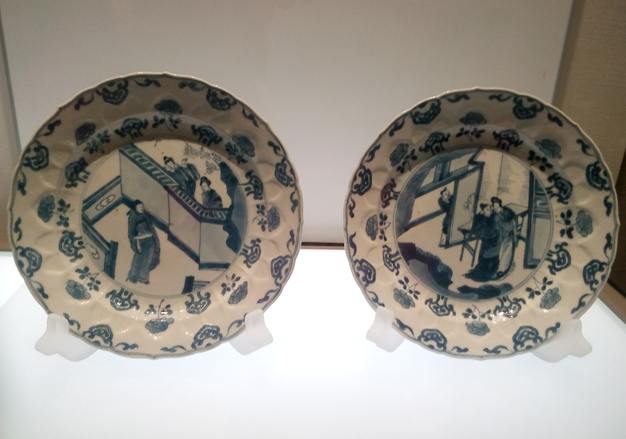
The Blue-and-white Paired Plates with Water Caltrop-shaped Rim and Drama Scenes, created during Emperor Kangxi’s reign, measures 21.6cm in mouth diameter, 4.8cm in foot diameter and 3.1cm in height, and is now in the collection of Henan Museum.